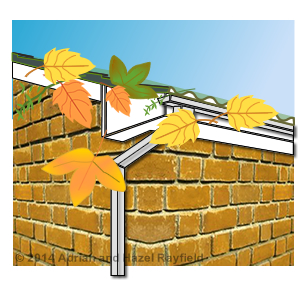Painting, decorating and home improvement tips blog
Saving money on your energy bills
Posted by Adrian
December 21st, 2018
Saving money on your energy bills

Over the past few weeks the UK has endured some very cold weather including strong winds and several centimetres of snow. The first thing people do when we get this type of weather is turn on the heating and turn it up, but could you be doing things to stop the cold draughts and heat loss from your home?
If you lose heat from your house you are literally burning money, badly fitting doors and windows are often a major contributory factor to heat loss as well as badly insulated walls and loft spaces. So what can be done?
By spending a little bit of time and money you can reduce your electricity, gas or water utility bills. Many things you can do yourself if your are a keen DIYer or Handyman.
Doors and windows
Draughts from around doors and windows not only let cold in but can allow heat to escape, you can fit a self-adhesive rubber or foam seal around the window or door to shut onto to reduce draughts, fitting brush draught excluders on the bottom of a door will reduce the cold from coming under the door. Even fitting a simple key hole cover over a door lock will reduce heat loss.

Ideally good fitting double glazed windows is the best option but these can be expensive to have fitted, but if you have single glazed windows you can still do more, such as fitting thick lined curtains and pulling them across mid afternoon as it gets dark and the temperature starts to drop. You could also fit secondary glazing throughout the winter months and remove it during the warmer summer months.
If you have a letterbox on your door consider fitting a draught proof flap on both sides, alternatively you can add a brush letterbox cover inside to reduce draughts and heat loss.
You can also buy, or make a draught excluder for the bottom of the door, these are often ‘sausage dogs’ if you buy them but can easily be made from and old pillow case and filled with old rags, whatever they are made from or the style they can reduce heat loss from the bottom of the door.
Lofts and Loft hatches
Heat rises so ensuring the loft space has enough insulation, current recommendations for mineral wool insulation is 270mm but other types of insulation may need more or less, check with the manufacturer. Also don’t forget flat roofs, they also need to be insulated.
Having a well fitted insulated and draught proofed loft hatch also can not be overlooked, no point in insulating the loft space then not doing the loft hatch. Attach insulation on the inside and fit a rubber seal for the hatch to shut onto, just like any other door.
Pipes and pipework
You can buy pipe lagging very cheaply and is easy to fit, it is often made from foam and can be fitted over the pipes, both hot and cold. You can also buy felt insulation but is harder to fit over installed pipework. If you buy the foam type just ensure you but the correct bore size for the size of copper pipe, normally either 15mm or 22mm.
Often an overlooked area is the outside, if you have pipes going outside, make sure the gaps around them are filled in, this includes plastic pipes such as waste pipes as well as copper pipes. If you have copper pies outside, lag these to stop them from freezing.
Radiators

If you have radiators, make sure you bleed the air out of them, to tell if they need doing feel the top, middle and bottom, if the top is colder it is more than likely filled with air and need bleeding. This is a simple job and all you need is a bleed key, then open the bleed valve on the radiator a small amount until water comes out, then do the bleed valve up tight again.
If you have cold areas in your radiator you are not using the radiator efficiently and if you turn the heating up to compensate for the cold area on the radiator you are using more energy to heat the bottom of the radiator, bleed them and turn the heating down a bit.
Hot water tanks
Your hot water cylinder is where you store your hot water, if this isn’t insulated properly and you lose heat from it you will need to keep re-heating the water, so using more energy. The insulation should be at least 75mm thick, if it isn’t you can buy a hot water cylinder jacket to wrap around it.
Walls

If your walls are not insulated but you have a cavity between the inner and outer walls it is worth insulating them, this will reduce the heat loss from your walls. If you are unsure if you have a cavity in you wall or if you are unsure if your walls have cavity wall insulation, if you can see your bricks, look at the pattern if it is regular you will more than likely have a cavity, if the bricks have alternate, that is if you can see a full length brick, then the end of a brick you may not have a cavity but a solid wall, check with a cavity wall insulation firm in your area.
If your house was built before or up to the 1920’s it is most likely to have solid walls, after this time it should have a cavity and any house built from the 1990’s will most likely have a cavity wall with cavity wall insulation.
As for the inside of the walls, you can line them with a thermal liner, this only really needs to be done on the exterior walls as it is fairly expensive, but can be done on all of the walls. By having a thermal liner it will help even more with the heat loss through your walls.
Solar Panels
If you wish to go a step further, you can install solar panels on your roof to help with your electricity bills, and even reduce your bills by feeding the grid with your unused electricity. Although initially expensive to install it is a long term investment.
Finally
Please remember that houses need to be ventilated to stop mould growth, wet and dry rot and to keep a healthy environment inside the house so please do not block any air bricks, window trickle vents or air vents such as those near a boiler.
With many of the ways to save money on your energy bills mentioned above, you may be able to get Government grants, financial support and even earn money such as if you install solar panels, so have a look around to see what you can get help with.
Tags: Cavity Wall, Door, Draught Excluder, Electric, Electricity, Gas, Insulation, Pipes, Radiators, Solar Panels, Solar Power, Thermal liner, Utility, Ventilation, Water, weather, Window
Posted in Home Improvements | No Comments »
Getting your home ready for winter
Posted by Adrian
December 8th, 2014
Getting your home ready for winter
After such a mild autumn we could be in for a harsh winter, so being prepared in advance is vital. Doing essential jobs before the winter sets in could prevent any issues during the winter months.
If you own property and rent it out it is advisable to get your rented property checked over as well, prevention is better than cure as they say.

What to check and fix before the winter
Things such as heating, boilers and radiators are the most obvious things to check and service before the winter, but less thought about things such as gutters and drains also need to be looked at.
Boiler, radiators and pipes
Getting your boiler serviced (by a qualified engineer) could not only prevent a break down when you need it most, but if it runs efficiently it could also save money on your gas bill.
Radiators should be bled to ensure no air is in the radiators and they can supply you with efficient heat, you can tell if your radiator needs bleeding as they will have a cold spot at the top, if it is cold at the bottom, this indicates a buildup of sludge and rust, this should be flushed out to get the most from your radiators this winter.
Pipes, these should be lagged including any pipes outside such as in outbuildings or garden taps. If pipes are not lagged and they freeze, they could burst and cause flooding.
You can read about how to avoid freezing pipes on our Rayfields site.
If you are going away, or you have a empty rented property, it is a good idea to leave the heating on low just to prevent pipes from freezing. Now is also a good time to know where stop cocks and valves are, just in case of an emergency.

Roofs, gutters and drains
Roofs take a battering in the winter with strong winds, rain, sleet and snow. It is a good idea to give it a visual inspection from the ground. If you have access to a ladder you could look at it closer but don’t get on the roof without the necessary safety equipment. Look for missing or broken tiles including ridge tiles, look at the state of the chimney if you have one. If anything needs repairing get it done sooner than later as roofers can get busy.
Gutters get full of falling leaves and can block the downpipes, clear guttering out and fit a downpipe leaf guard to stop debris falling down the downpipe. Also check where the downpipe goes, is it an open drain, does this flow well or is it blocked? A blocked drain could cause damp to your property.
You can read a post I did about cleaning out your gutters on our Rayfields site.

Insulation, doors, windows
Does your loft have enough insulation in it? Are any pipes and hot water tank properly lagged all these should be looked at for both rented and private owned properties. Are you walls cavity insulated or can they be, you may even be able to have it installed for free. So it is worth a little time checking.
Do your windows and doors fit and close as they should? If you have draughts you could fit draughts excluders around windows and doors. If your windows don’t shut well because the handle is broken, get it fixed, reducing draughts will help keep the heat in and cold out, thus saving on heating bills.

Tags: Bleed, Boiler, Doors, Drains, Freeze, Guttering, gutters, Home, House, Insulation, Pipes, Property, Radiators, Rented, Roof, Windows
Posted in Decorating Tips | No Comments »
